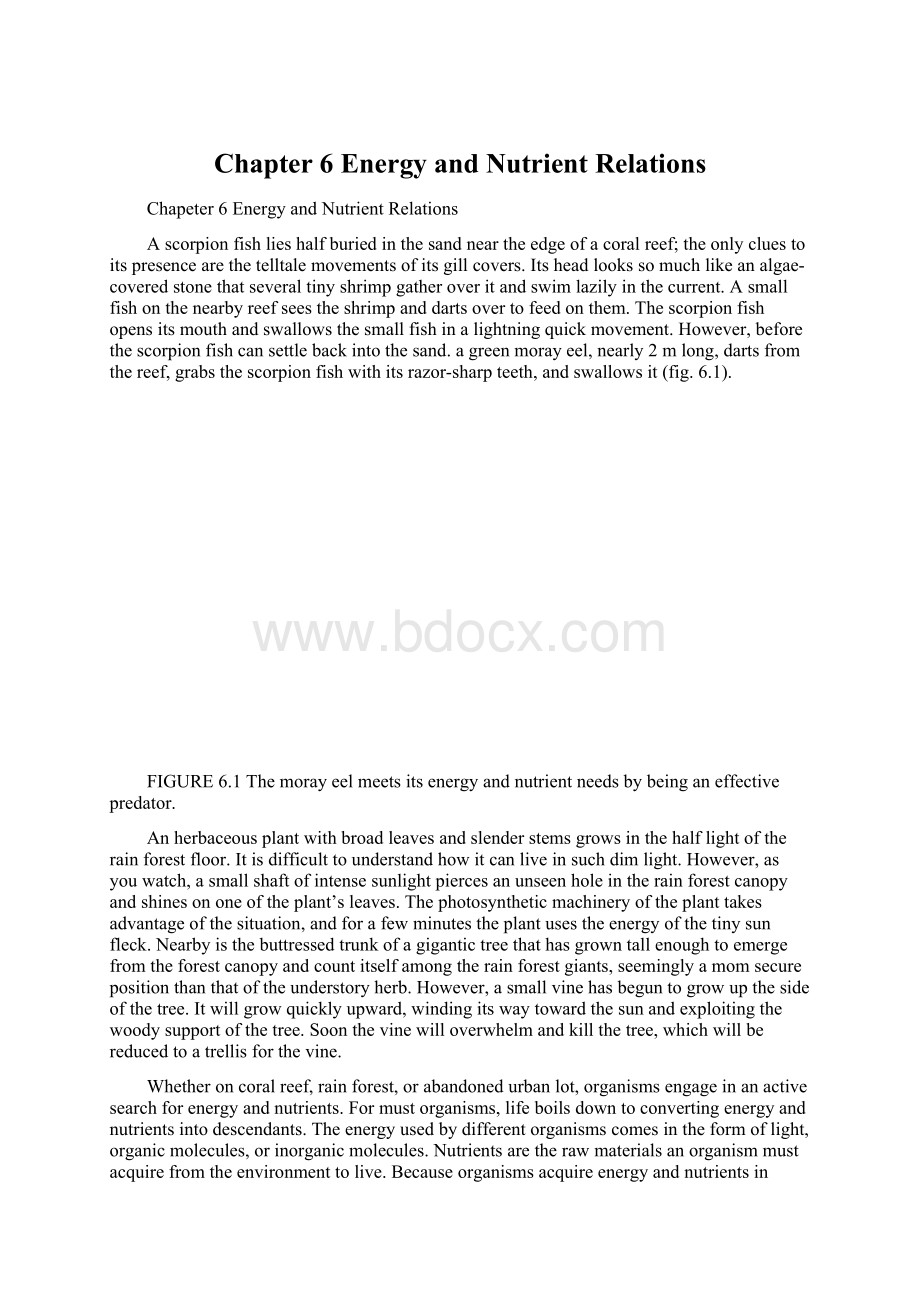Chapter 6Energy and Nutrient Relations.docx
《Chapter 6Energy and Nutrient Relations.docx》由会员分享,可在线阅读,更多相关《Chapter 6Energy and Nutrient Relations.docx(37页珍藏版)》请在冰豆网上搜索。

Chapter6EnergyandNutrientRelations
Chapeter6EnergyandNutrientRelations
Ascorpionfishlieshalfburiedinthesandneartheedgeofacoralreef;theonlycluestoitspresencearethetelltalemovementsofitsgillcovers.Itsheadlookssomuchlikeanalgae-coveredstonethatseveraltinyshrimpgatheroveritandswimlazilyinthecurrent.Asmallfishonthenearbyreefseestheshrimpanddartsovertofeedonthem.Thescorpionfishopensitsmouthandswallowsthesmallfishinalightningquickmovement.However,beforethescorpionfishcansettlebackintothesand.agreenmorayeel,nearly2mlong,dartsfromthereef,grabsthescorpionfishwithitsrazor-sharpteeth,andswallowsit(fig.6.1).
FIGURE6.1Themorayeelmeetsitsenergyandnutrientneedsbybeinganeffectivepredator.
Anherbaceousplantwithbroadleavesandslenderstemsgrowsinthehalflightoftherainforestfloor.Itisdifficulttounderstandhowitcanliveinsuchdimlight.However,asyouwatch,asmallshaftofintensesunlightpiercesanunseenholeintherainforestcanopyandshinesononeoftheplant’sleaves.Thephotosyntheticmachineryoftheplanttakesadvantageofthesituation,andforafewminutestheplantusestheenergyofthetinysunfleck.Nearbyisthebuttressedtrunkofagigantictreethathasgrowntallenoughtoemergefromtheforestcanopyandcountitselfamongtherainforestgiants,seeminglyamomsecurepositionthanthatoftheunderstoryherb.However,asmallvinehasbeguntogrowupthesideofthetree.Itwillgrowquicklyupward,windingitswaytowardthesunandexploitingthewoodysupportofthetree.Soonthevinewilloverwhelmandkillthetree,whichwillbereducedtoatrellisforthevine.
Whetheroncoralreef,rainforest,orabandonedurbanlot,organismsengageinanactivesearchforenergyandnutrients.Formustorganisms,lifeboilsdowntoconvertingenergyandnutrientsintodescendants.Theenergyusedbydifferentorganismscomesintheformoflight,organicmolecules,orinorganicmolecules.Nutrientsaretherawmaterialsanorganismmustacquirefromtheenvironmenttolive.Becauseorganismsacquireenergyandnutrientsindiverseways,weneedtoorganizeourdiscussionundertheumbrellaofmajorconcepts.Inchapter6,wefocusonthree.
CONCEPTS
●Organismsuseoneofthreemainsourcesofenergy:
light,organicmolecules,orinorganicmolecules.
●Therateatwhichorganismscantakeinenergyislimited.
●Optimalforagingtheoryattemptstomodelhoworganismsfeedasanoptimizingprocess.
CASEHISTORIES:
energysources
Organismsuseoneofthreemainsourcesofenergy:
light,organicmolecules,orinorganicmolecules.
Howdowegrouporganisms?
Wegenerallygrouporganismsonthebasisofsharedevolutionaryhistories,creatingtaxasuchasvertebrateanimals,insects,coniferoustrees,andorchids.However,wecanalsoclassifyorganismsbyhowtheyobtainenergy--thatis,bytheirtrophic(feeding)biology.Organismsthatuseinorganicsourcesofbothcarbonandenergyarecalledautotrophs("self-feeders")andareoftwotypes,photosyntheticandchemosynthetic.Photosyntheicautotrophsusecarbondioxide(CO2)asasourceofcarbonandlightasasourceofenergy.Thisgroupincludestheplants,photosyntheticprotists,andphotosyntheticbacteria.Chemosyntheticautotrophsuseinorganicmoleculesasasourceofcarbonandenergy.Thesearemadeupofahighlydiversegroupofchemosyntheticbacteria.Heterotmphs("other-feeders")areorganismsthatuseorganicmoleculesbothasasourceofcarbonandasasourceofenergy.Theheterotrophsincludebacteria,fungi,protists,animals,andparasiticplants.
Bacteriashowmoretrophicdiversitythantheotherbiologicalkingdoms(fig.6.2).Theprotistsareeitherphotosyntheticorbeterotrophic,mostplantsarephotosynthetic,andallfungiandanimalsareheterotrophic.Incontrast,thebacteriaincludephotosynthetic,chemosynthetic,andheterotrophicspecies,makingthem,asagroup,themosttrophicallydiverseorganismsinthebiosphere.
FIGURE6.2Trophicdiversityacrossthebiologicalkingdoms.
UsingLightandCO2
Becausephotosyntheticorganismsuselightasasourceofenergy,weneedtolearnaboutlight.WealsoneedtounderstandhowphotosyntheticorganismsuseCO2.Thesearetopicsweinvestigatenext.
TheSolar-PoweredBiosphere
Aswesawinchapters2and3,solarenergypowersthewindsandoceancurrents,andannualvariationinsunlightintensitydrivestheseasons.Inchapter4,wealsodiscussedhoworganismsusesunlighttoregulatebodytemperature.Here,buildingonthosediscussions,welookatlightasasourceofenergyforphotosynthesis.
Lightpropagatesthroughspaceasawave,withallthepropertiesofwavessuchasfrequencyandwavelength.Whenlightinteractswithmatter,however,itactsnotasawavebutasaparticle.Particlesoflight,calledphotons,bearafinitequantityofenergy.Longerwavelengths,suchasinfraredlight,carrylessenergythanshorterwavelengths,suchasvisibleandultravioletlight.
Infraredlight,aswesawinchapter4(seefig.4.13),isveryimportantfortemperatureregulationbyorganisms.Thisisbecausethemaineffectofinfraredlightonmatteristoincreasethemotionofwholemolecules,whichwemeasureasincreasedtemperature.However,infraredlightdoesnotcarryenoughenergytodrivephotosynthesis.Attheotherendofthesolarspectrum,ultravioletlightcarriessomuchenergythatitbreaksthecovalentbondsofmanyorganicmolecules.Becauseitcanbreakdownorganicmolecules,ultravioletlightcandestroythecomplexbiochemicalmachineryofphotosynthesis.Betweentheseextremesisthelightwecansee,so-calledvisiblelight,whichisalsocalledphotosyntheticallyactiveradiation,orPAR.PAR,withwavelengthsbetweenabout400and700nm,carriessufficientenergytodrivethelight-dependentreactionsofphotosynthesisbutnotsomuchastodestroyorganicmolecules.PARmakesupabout45%ofthetotalenergycontentofthesolarspectrumatsealevel,whileinfraredlightaccountsforabout53%andultravioletlightfortheremainder.
MeasuringPAR
EcologistsquantifyPARasphotonfluxdensity.Photontluxdensityisthenumberofphotonsstrikingasquaremetersurfaceeachsecond.Thenumberofphotonsisexpressedasmicromoles(μmol),where1moleisAvagadro'snumberofphotons,6.023×1023.Togiveyouapointofreference,aphotonfluxdensityofabout4.6μmolpersquaremeterpersecondequalsalightintensityofabout1wattpersquaremeterMeasuringlightasphotosyntheticphotonfluxdensitymakessenseecologicallybecausechlorophyllabsorbslightasphotons.
Lightchangesinquantityandqualitywithlatitude,withtheseasons,withtheweather,andwiththetimeofday.Inaddition,landscapes,water,andevenorganismsthemselveschangetheamountandqualityoflight.Forexample,inaquaticenvironments(seechapter3),onlythesuperficialeuphoriczonereceivessufficientlighttosupportphotosyntheticorganisms.Inaddition,lightchangesinquality,aswellasquantity,withintheeuphoticzone,whichrangesindepthfromafewmeterstoabout100m(seefig.3.7).
Asinthesea,sunlightchangesasitshinesthroughthecanopyofaforest.Amaturetemperateortropicalforestcanreducethetotalquantityoflightreachingtheforestfloortoabout1%to2%oftheamountshiningontheforestcanopy(fig.6.3).However,forestsalsochangethequalityofsunlight.Withintherangeofphotosyntheticallyactiveradiation,leavesabsorbmainlyblueandredlightandtransmitmostlygreenlightwithawavelengthofabout550nm.Asinthedeepsea,theorganismsontheforestfloorliveinakindoftwilight.Onlyhere,thetwilightisgreen(seefig.2.9).
FIGURE6.3Photosyntheticallyactiveradiation(PAR)inaborealforest(datafromLarcher1995.afterKairiukstis1967).
AlternativePhotosyntheticPathways
Duringphotosynthesis,thephotosyntheticpigmentsofplants,algae,orbacteriaabsorblightandtransfertheirenergytoelectrons.Subsequently,theenergycarriedbytheseelectronsisusedtosynthesizeATPandNADPH.Thesemolecules,inturn,serveasdonorsofelectronsandenergyforthesynthesisofsugars.Inthisway,photosyntheticorganismsconverttheelectromagneticenergyofsunlightintoenergy-richorganicmolecules,thefuelthatfeedsmostofthebiosphere.Withinphotosyntheticorganisms,specificbiochemicalpathwayscarryoutthisenergyconversion;threedifferentbiochemicalpathwaysareknown:
C3photosynthesis,C4photosynthesis,andCAMphotosynthesis.Thesearefoundinecologicallydifferentorganisms.
Biologistsoftenspeakofphotosynthesisas"carbonfixation,''whichreferstothereactionsinwhichCO2becomesincorporatedintoacarbon-containingacid.Inthephotosyntheticpathwayusedbymostplantsandallalgae,theCO2firstcombineswithafive-carboncompoundcalledribulosebisphosphate,orRuBP.Theproductofthisinitialreaction,whichiscatalyzedbytheenzymeRuBPcarboxylase,isphosphoglycericacid,orPGA,athree-carbonacid.Therefore,thisphotosyntheticpathwayisusuallycalledC3photosynthesisandtheplantsthatemployitarecalledC3plants(fig.6.4).
FIGURE6.4C3photosynthesis.
Tofixcarbon,plantsmustopentheirstomatatoletCO2intotheirleaves,butasCO2enters,waterexits.WatervaporflowsoutfasterthanCO2flowsin.ThemovementofwaterismorerapidbecausethegradientinwaterconcentrationfromtheleaftotheatmosphereismuchsteeperthanthegradientinCO2concentrationfromtheatmospheretotheleaf.InCO3plants,thereisanotherfactorthatcontributestoalowrateof